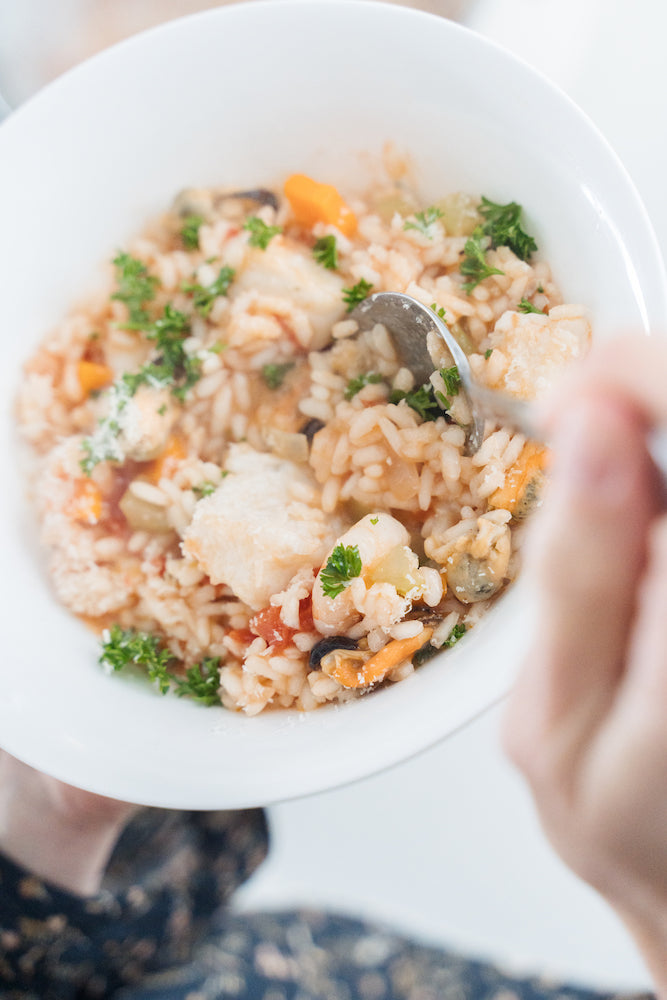This Easy And Authentic Malaysian Chicken Rendang Recipe Is Easy To Prepare And Absolutely Perfect For A Flavourful Dinner
When you think of chicken rendang, also known as rendang chicken or ayam rendang, a comforting and spicy dish comes to mind. The flavours burst on your taste buds as you savour the richness of the coconut milk and aromatic blend of whole spices.
Chicken rendang is typically slow-cooked for a few hours to build up the flavours. But you'd be pleased to know that our chicken rendang recipe is a quick and easy version without compromising on the rich and intense flavours we all know and love.
Whether a beginner or a seasoned home cook, you can prepare this comfort dish using ingredients easily found in your local supermarket. Therefore, you can whip up this dish for dinner in no time and enjoy the best chicken rendang paired with plain rice while watching your favourite shows.
Before you begin cooking this dish, don't forget to review the recipe's FAQs below for a better understanding of the recipe and improve your chances of mastering this comfort dish. In fact, this recipe will become one of your favourite recipes to prepare to impress your partner, family, and friends!

What Is Chicken Rendang?
Chicken rendang is a hearty Malaysian stew with Indonesian origins, that is made from tender chicken pieces, be it skinless chicken breasts, chicken thighs, or chicken drumsticks, a rendang spice paste, exotic spices, kerisik, and coconut milk. It is usually served with a bed of steamed rice or white bread. Some even serve it with roti jala.
Chicken rendang recipes usually use bone-in chicken thighs as it is tender and does not dry out as fast. The chicken pieces are cooked in full-fat coconut milk, giving the rendang a creamy texture and a subtle sweetness to balance the spiciness.
While this recipe uses vegetable oil while cooking rendang, you can opt for coconut oil to stir-fry the rendang paste and other spices. Sugar is also added to the dish to balance the spiciness and acidity, which can be easily substituted with palm sugar or coconut sugar for a more complex flavour.
After blending the ingredients to make a fine paste, heat the oil in the Cosmo wok before adding the smooth paste and other spices. Then, stir-fry over medium-high heat until fragrant. Then, add the chicken thighs, lemon grass, coconut milk, and water before simmering on medium heat. Continue stirring frequently until the chicken thighs are almost cooked.
Then, stir again after adding the kaffir lime leaves and kerisik to combine well. Cover the wok with the lid and simmer the rendang at low heat for 30 minutes or until the chicken is tender and the liquid has dried up.
If you prefer a thicker sauce, remove the chicken and let the sauce simmer for another 15 minutes uncovered. Add more salt and sugar to taste before serving immediately.
Wait...You Mentioned That Rendang Originated From Indonesia. Isn't It A Malaysian Dish?
The traditional rendang is strongly believed to have originated from Indonesia, in particularly West Sumatra. Its origins go back to pre-modern age of the Minangkabau people, where rendang was prepared only during special ceremonies like birthdays, marriages, and festive periods like Eid, where the rendang was a special dish to honour guests.
It was as such because the very act of making rendang back then was an arduous task that involved slow cooking rendang over an open flame for several hours until the spices and coconut milk are fully absorbed into the meat. Not to mention the preparation for the rendang paste took an incredibly long time, whereas we can now have our rendang paste completed in the push of a button on the food processor.
Additionally, the traditional rendang of Indonesia is a dry meat dish that was also packed by merchants and traders of West Sumatra who often embarked on lengthy trade journeys that went beyond months. But of course, even though the rendang of old was said to have lasted up to 4 weeks, the delicious dish would naturally be wolfed down by the hungry merchants before that. ;)
What Is Rendang Sauce Made Of?
Spices such as the cinnamon stick, cloves, star anise, and cardamom pods add different aromas and flavours that add to the signature richness and depth of a rendang dish.
Don't forget the kaffir lime leaves and kerisik (toasted coconut)! The leaves of kaffir limes infuse this rendang recipe with a hint of bitterness and citrusy flavour. Meanwhile, kerisik, known as toasted grated coconut, has a nutty and sweet flavour. These two ingredients add a lovely contrast to the spiciness of the chicken rendang.

How Is Rendang Different From Curry?
Rendang is an aromatic Malaysian stew that involves simmering meat in spices and coconut milk for a few hours until the meat is tender, and the sauce is reduced to a thick consistency. Some even consider rendang as a dry curry as it does not have as much gravy as a curry. While this recipe does not include tamarind pulp or tamarind juice, feel free to add it for an extra kick of acidity to your rendang.
Meanwhile, curry comprises a mixture of vegetables, meat, and legumes cooked in a gravy of spices such as turmeric powder, cumin, and chilli powder. Curry typically takes a shorter time to prepare over rendang as the ingredients do not have to be reduced to a thick gravy, but is instead allowed to remain watery.

What Are The Ingredients In Chicken Rendang Paste?
The rendang paste comprises of shallots, galangal, lemongrass, garlic, ginger, and dried red chillies. The spice paste ingredients are what make rendang sauce so savoury and delectable with an intense and complex flavour profile.
The dried red chillies are the star of the spice paste. It contributes to the spiciness of the chicken rendang and is further enhanced by garlic for its savoury taste.
The shallots add a mild and sweet flavour to the rendang, enhancing the depth of the rendang paste. Lemongrass is also added to further balance the texture of the creamy coconut milk and add a touch of brightness to the dish.
Meanwhile, the galangal's unique aroma is complemented by the ginger's slight naturally spicy flavours, adding another layer of complexity to the spice paste.
After blending these ingredients in a small food processor, add the spice paste during the cooking process to your chicken rendang and you'll be blown away by its aromatic flavours.

Why Is My Rendang So Watery?
Your rendang may be very watery if you have not allowed it to simmer long enough. Thus, remove the chicken with a slotted spoon and continue cooking the rendang uncovered until the sauce has thickened to your preferred consistency. You'll want to remove the chicken from the rendang because chicken tends to get tough and loses its juiciness when overcooked.
The rendang may also be very watery if you've added too much liquid. Thus, drain some of the liquid away before you continue simmering the rendang.
Some households opt to add in cornstarch to thicken their rendang when it becomes too watery. But I find that it gives the rendang gravy an undesirable thick paste-like texture. Which is why I strongly recommend reducing it over low heat with the lid off for an extended duration to allow the flavours to intensify while thickening it naturally.
Can Rendang Be Kept Overnight?
Yes, you can store rendang overnight. Like most stews and braised dishes, rendang usually tastes better after it's been stored overnight in the fridge.
Once your rendang has cooled to room temperature, store it in an airtight container in the fridge for up to 3 days.
You can reheat leftover rendang on the stove, stirring from time to time to prevent burning. Alternatively, you can reheat it in the microwave, stirring between short intervals. If you find the rendang to be too dry, you can add a splash of water or coconut milk to give it a depth of creaminess.

Can I Substitute Kaffir Lime Leaves?
Kaffir lime leaves give off a lovely citrusy flavour, balancing the richness and spiciness of the chicken rendang.
In a pinch, you can substitute kaffir lime leaves with kaffir lime zest or lime zest. While lime zest does not have the same intense flavour as the kaffir lime leaves, it still works rather well. You can use the zest of one lime for every two kaffir lime leaves.
What If I Don't Have Chicken Thighs?
You can substitute chicken thighs for boneless chicken breasts. However, chicken thighs are usually more tender and flavorful due to their higher fat content.
As chicken breast is leaner, avoid overcooking it as it may become too dry. Thus, reduce the simmering time slightly and remove the chicken breasts when fully cooked. Another, more flavourful way involves letting the chicken cook in oil for a bit to brown before combining the rest of the rendang ingredients to simmer. Besides, you can add slightly more coconut milk or coconut cream to make up for the lower fat content.
A fine alternative is to use chicken drumsticks as they are as tender and juicy as chicken thighs.
Can I Substitute Coconut Milk In The Chicken Rendang Recipe?
Typically, we add coconut milk to chicken rendang for its creamy texture and subtle sweetness, which balances the spiciness of the dried red chillies. While coconut milk does not have monounsaturated fat, it is high in saturated fat, vitamins, and minerals.
But if you need a substitute for coconut milk, reach for coconut cream, which has a thicker consistency than coconut milk. To dilute the coconut cream to achieve the consistency of coconut milk, you can add half a cup of water to half a cup of coconut cream.
Are There Any Substitutes For Kerisik?
Kerisik is an essential ingredient used in many Southeast Asian dishes, such as rendang and nasi ulam. It is roasted coconut that has been ground into a paste. It adds a nutty flavour to our chicken rendang recipe, bringing the depth of flavours to the next level.
If you can't find kerisik, you can use fresh or frozen grated coconut to make your own. If you're using frozen grated coconut, let it thaw completely before frying it.
After heating a pan on medium-low heat, dry the grated coconut for a few minutes, stirring constantly. Once the coconut bits have cooled down, pound them in a pestle and mortar until they reach a paste-like consistency. Then, you can add the paste to the food processor with the other ingredients to make your spice paste for the rendang.

Can I Make A Beef Rendang?
If you're not a fan of eating chicken, you absolutely can go for a beef rendang recipe instead of sticking to the chicken version. However, there are a few differences between a chicken and beef version of the recipe.
For starters, beef is typically tougher than chicken. Thus, it will take longer for the meat to become tender. On the other hand, chicken cooks faster than beef as the meat is leaner.
A beef rendang is also drier than a chicken rendang because the coconut milk is almost completely reduced until the gravy thickens. Beef also has a more robust flavour and contains a higher natural fat, contributing to the depth and richness of the beef rendang.
Can I Make A Vegetarian Rendang?
Yes, you can make a vegetarian rendang, which is just as delicious and does not compromise on its flavours.
Firm tofu and tempeh are excellent protein substitutes for chicken as they absorb the intense flavours and spices well. You can also consider using mushrooms and canned young jackfruit for its meaty texture that adds a nice touch to the vegetarian rendang.




